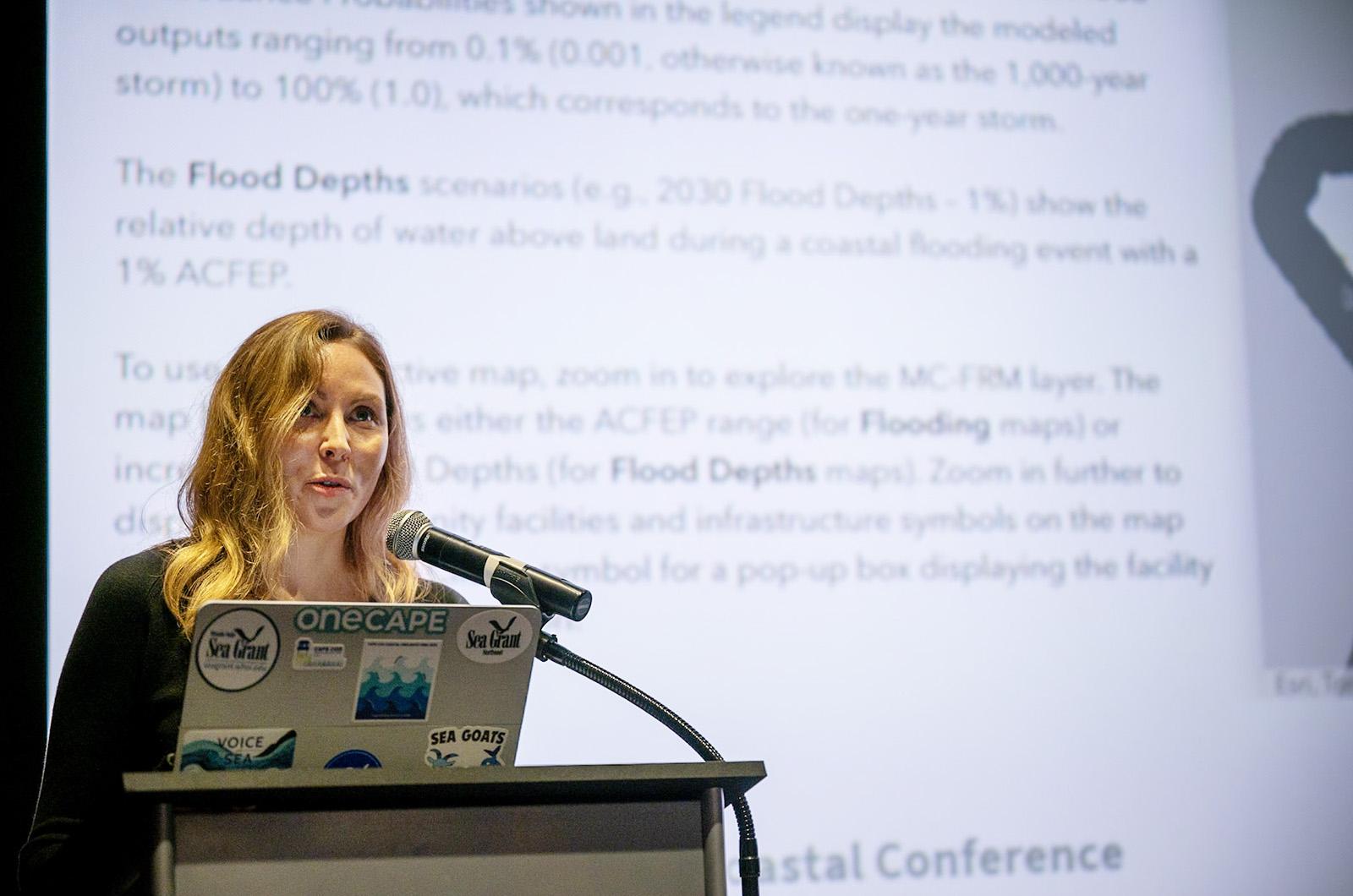Today’s storm is tomorrow’s high tide. That’s how Deanna Moran, the Massachusetts chief coastal resilience officer, explained the importance of getting ahead of the impacts of climate change.
Ms. Moran presented her keynote talk Tuesday at the Islands Coastal Conference, a day-long event held at the Film Center in Vineyard Haven.
The conference was spearheaded by the Woods Hole Oceanographic Institution Sea Grant, a program established in 1973. Ms. Moran was joined by a panel of experts, Island officials and representatives from local organizations, including the Martha’s Vineyard Commission, Wampanoag Tribe of Gay Head (Aquinnah) and The Trustees of Reservations.
This year’s conference focused on coastal resilience, the ability to recover from and adapt to the effects of coastal flooding.
“The mindset, at least when I was getting into this work, was that somehow focusing on resilience instead of curbing emissions, was giving up on the climate crisis,” Ms. Moran told the crowd of approximately 100 people. “We now know that we have to be doing both...even if we were to reduce emissions to zero overnight, there’s a certain amount of impact that we are locked into that is something that we unfortunately have to learn to live with, because that bill is going to come due no matter what.”
Shelly McComb, a coastal resilience specialist with WHOI Sea Grant, said that the coastal conference — an annual event that alternates between Martha’s Vineyard and Nantucket — was inspired by work on the Cape.
“This started on the Cape,” she said. “The Waquoit Bay National Researchers do a coastal conference. We serve the Cape and Islands and saw there was a need for education.”
Ms. McComb added that when local officials met with WHOI Sea Grant to plan the conference, they stressed the need to focus on resilience.
Liz Durkee, the climate change coordinator at the Martha’s Vineyard Commission, said the topic was a clear choice.
“A lot of years, we focus on water quality or other issues, but I think as we see the impact of climate change, it feels important to look at resilience. Look at Asheville [NC]just this week,” Ms. Durkee said. “We aren’t prepared.”
Presentations looked at many aspects and eras of the Vineyard’s coastline.
Jane Varkonda, parks commissioner and the conservation agent for Edgartown, detailed the impacts of the winter storms that battered the Island’s south shore this past winter. At South Beach, flooding created a sink hole in Atlantic Drive that cut off access to several homes. Ms. Varkonda also spoke about the recovery efforts to restore the beaches, including transporting dredged sand and planting beachgrass to bolster dunes.
Bret Stearns, the natural resources director for the Wampanoag Tribe of Gay Head (Aquinnah), recalled Hurricane Sandy, which hit the Island in 2012. He said the recovery was complicated by the fact that the damage wrought by the storm impacted both tribal and town lands, which made getting funding from the federal government more difficult. Mr. Stearns also highlighted the current work being done by the natural resources department and the Wampanoag Environmental Laboratory to monitor the climate and improve resilience on the Island.
“The hub of our environmental programs start at the lab,” Mr. Stearns said. “We’re a resource where people are trying to figure out problems on the Island.”
The lab monitors air quality on Island and runs water quality samples, among other activities. The staff works on a wide variety of projects related to natural resources, including curbing invasive species and securing energy sovereignty.
Eileen Gunn, an associate project manager at Fuss & O’Neil, presented the firm’s findings on risk assessment regarding hospital access during floods. Last year, the town received a grant to fund an initial risk assessment to look at EMS access to the hospital which is located in an active flood zone. According to the study, it takes almost three minutes to get from Vineyard Haven to the hospital. Based on the projections for 2030, navigating around flooded streets could add almost nine minutes to that response time.
Ms. Gunn also spoke about potential solutions, including raising the roads and nature-based possibilities, to dune enhancement and installing devices to lessen the impact of waves.
The conference took a wider approach too, looking at coastal resilience throughout the region, different responses to flood risk and issues related to insurance in coastal regions.
“This meeting is really valuable because we are always saying we need to get people in the same room and get the message out,” said Emma Green-Beach, the executive director of Martha’s Vineyard Shellfish Group and member of the Oak Bluffs select board. “As we sit here, a lot of us are thinking about how to implement these things in our own towns.”









Comments
Comment policy »